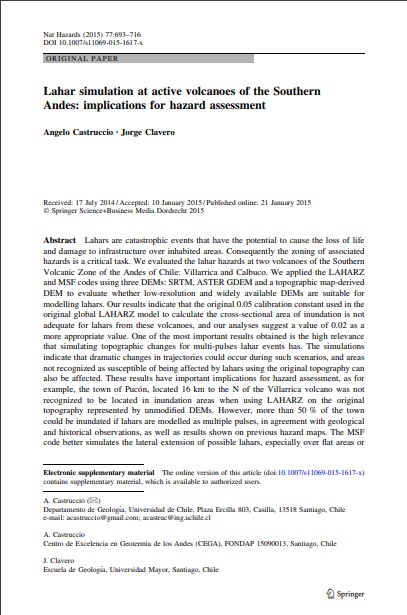Lahar simulation at active volcanoes of the Southern Andes: implications for hazard assessment

Fecha
2015Autor
Clavero J.
Castruccio, Angelo [Escuela de Geología, Universidad Mayor, Chile]
Ubicación geográfica
Notas
HERRAMIENTAS
Acceda a títulos restringidos
¿Cómo descargar?Resumen
Lahars are catastrophic events that have the potential to cause the loss of life and damage to infrastructure over inhabited areas. Consequently the zoning of associated hazards is a critical task. We evaluated the lahar hazards at two volcanoes of the Southern Volcanic Zone of the Andes of Chile: Villarrica and Calbuco. We applied the LAHARZ and MSF codes using three DEMs: SRTM, ASTER GDEM and a topographic map-derived DEM to evaluate whether low-resolution and widely available DEMs are suitable for modelling lahars. Our results indicate that the original 0.05 calibration constant used in the original global LAHARZ model to calculate the cross-sectional area of inundation is not adequate for lahars from these volcanoes, and our analyses suggest a value of 0.02 as a more appropriate value. One of the most important results obtained is the high relevance that simulating topographic changes for multi-pulses lahar events has. The simulations indicate that dramatic changes in trajectories could occur during such scenarios, and areas not recognized as susceptible of being affected by lahars using the original topography can also be affected. These results have important implications for hazard assessment, as for example, the town of Pucn, located 16 km to the N of the Villarrica volcano was not recognized to be located in inundation areas when using LAHARZ on the original topography represented by unmodified DEMs. However, more than 50 % of the town could be inundated if lahars are modelled as multiple pulses, in agreement with geological and historical observations, as well as results shown on previous hazard maps. The MSF code better simulates the lateral extension of possible lahars, especially over flat areas or where topography is complex with many stream trajectories, but lacking a reliable method to determine the run-out distance. Our results indicate that the modifications made to the LAHARZ governing equations give very good results for assessing the hazards associated with lahars in volcanoes of this region of the Andes.
URI
https://link.springer.com/content/pdf/10.1007/s11069-015-1617-x.pdfhttp://dx.doi.org/10.1007/s11069-015-1617-x
http://repositorio.umayor.cl/xmlui/handle/sibum/6910
Coleccion/es a la/s que pertenece:
Si usted es autor(a) de este documento y NO desea que su publicación tenga acceso público en este repositorio, por favor complete el formulario aquí.